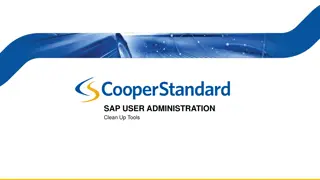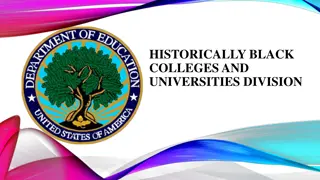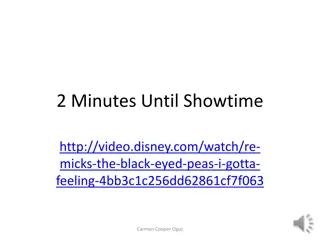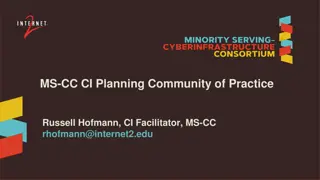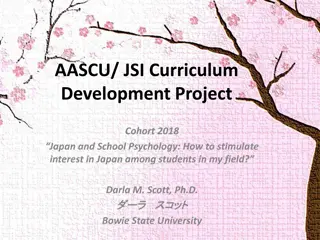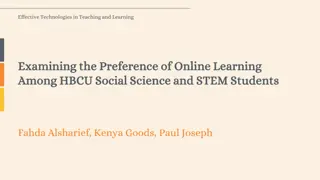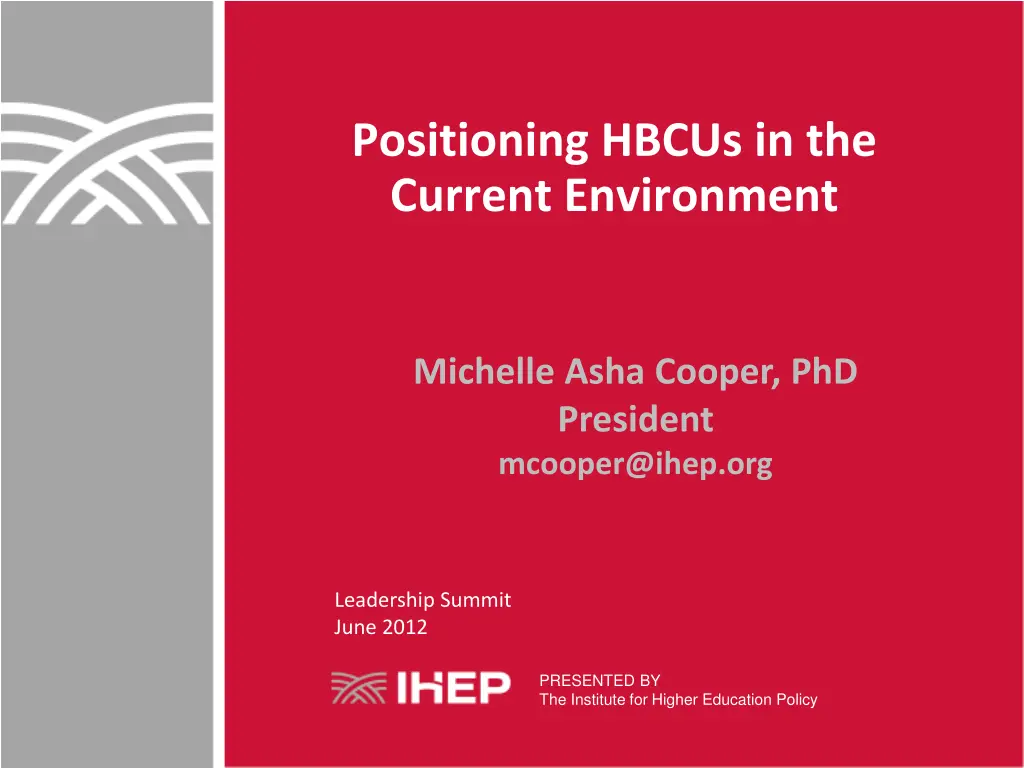
Positioning HBCUs in the Higher Education Landscape
Learn about the crucial role of Historically Black Colleges and Universities (HBCUs) in the current higher education environment, focusing on their enrollment of African-American students and their contribution to bachelor's degree attainment. Explore data and insights presented by the Institute for Higher Education Policy on college access and success, along with the challenges faced by underserved populations in pursuing higher education goals.
Uploaded on | 7 Views
Download Presentation

Please find below an Image/Link to download the presentation.
The content on the website is provided AS IS for your information and personal use only. It may not be sold, licensed, or shared on other websites without obtaining consent from the author. If you encounter any issues during the download, it is possible that the publisher has removed the file from their server.
You are allowed to download the files provided on this website for personal or commercial use, subject to the condition that they are used lawfully. All files are the property of their respective owners.
The content on the website is provided AS IS for your information and personal use only. It may not be sold, licensed, or shared on other websites without obtaining consent from the author.
E N D
Presentation Transcript
Positioning HBCUs in the Current Environment Michelle Asha Cooper, PhD President mcooper@ihep.org Leadership Summit June 2012 PRESENTED BY The Institute for Higher Education Policy
About IHEP Our Vision The Institute for Higher Education Policy (IHEP) envisions a world where all people particularly populations who have been underserved have the opportunity to reach their full potential by participating and succeeding in higher education. Our Mission IHEP is committed to improving college access and success in higher education for all students with a special focus on underserved populations by providing timely research to inform public policy decisions. 2
OVERVIEW OF THE HIGHER EDUCTION LANDSCAPE PRESENTED BY The Institute for Higher Education Policy
The College Completion Agenda Obama Administration s Education Goal: The President's Bold Goal: Have the highest proportion of college graduates in the world by 2020. The Lumina Foundation for Education: Increase the percent of Americans with a two or four year degree from 37.9% to 60% by 2025 The College Board: At least 55 percent of the U.S. population holds a college degree or certificate by 2025 4
Low-income children are less likely to enroll in college, less likely to graduate 5
Highest Level of Attainment by Low-Income Young Adults, 2008 (by percent) 100% 6 6 7 14 90% 20 80% 30 37 37 70% 51 60% 50% 62 33 28 30 40% 30% 22 20% 31 28 26 11 10% 13 7 0% African American Asian American Latino/a Native American White Less than HS HS Diploma / GED College Enrollment Degree Attained Source: IHEP (2010). Portraits of Low-Income Young Adults 6
Change in Highest Level of Attainment by African Americans, 2000 and 2008 (by percent) 40 37 34 35 32 30 29 30 26 25 20 15 10 6 5 5 0 2000 2008 Less than HS HS Diploma / GED College Enrollment Degree Attainment Source: IHEP (2010). Portraits of Low-Income Young Adults 7
HBCUs within the Current Landscape Enroll 11 percent of all African-American students Award approximately 22 percent of all bachelor s degrees to African Americans: 35 percent of astronomy, biology, chemistry, mathematics, and physics graduates 50 percent of all African American teachers 24 percent of all African American science and engineering graduates 8 Source: Nelms, Charlie (2011). Strengthening America s Historically Black Colleges and Universities: A Call to Action.
Drivers of the College Completion Agenda Global Imperative Globalized knowledge economy 21st Century consciousness Economic Imperative Current labor market signals Future workforce readiness Equity Imperative Fastest-population growth occurring among racial/ethnic minorities Growing need to reengage and retrain growing number of adult learners Stratification along socioeconomic status 9
Building Blocks for College Success Academics Academic and Social Support Services Financial Assistance 10
Financial Need Contributes to Failure to Complete Too much work Too little sleep Work/Loan Burden Too little studying Stress Poor grades Housing and food insecurity Part-time enrollment Failure to complete 11 Source: CLASP, 2011
(Proven) Promising Practices: Strategies that Support Student Success Institutions should amplify their capacity to identify and track students, particularly those most at-risk Engage faculty early in the process and provide continuous support Embrace curricular change as a way to improve student success Institutions must ensure that promising practices are visible both internally and externally Institutional leaders must be VOCAL participants in policy conversations, particularly those related to accountability and affordability 12 Source: IHEP (forthcoming): Supporting First-Generation College Students Through Classroom-Based Practices
Recommendation 1: Institutions should amplify their capacity to identify and track students, particularly those most at-risk Evidence-Based Solutions an Holistic Approaches to Success Strategy STRATEGY HOW RESULT Identifying the number of potentially at-risk students as a means to corroborate institutional efforts. Create methods via admissions and orientation to ascertain specific number of students upon enrollment. More targeted approach to the types of at-risk students. Using qualitative and quantitative approaches to understanding and supporting first-generation students. Use national and institutional- created data sets to track student outcomes. Stronger programmatic design and institutionalization efforts. Utilizing traditional research modeling and design to track effective practices and first- generation students progression. Use interviews and focus groups to enhance anecdotal understanding. Stronger analysis and evidence of what works. Thinking beyond standard measures of success. Examine nonstandard measures of student learning (noncognitive, self-regulation, etc.). More holistic approach to engagement and learning. 13 Source: IHEP (forthcoming): Supporting First-Generation College Students Through Classroom-Based Practices (graphic modified)
Recommendation 2: Engage faculty early in the process and provide continuous support Faculty as Key Allies STRATEGY HOW RESULT Formalizing and reinforcing changes to faculty roles as related to student success. Required professional development sessions. Unique inter- and intradisciplinary exchanges. Scholarly and collaborative faculty learning communities. Greater cohesion around student success goals and learning outcomes. Clearer expectations of faculty roles inside and outside of the classroom. Formalizing and reinforcing changes to faculty roles as related to student success. Explicit language to support at- risk students in faculty position descriptions. Formal recognition as part of performance evaluations and incentives.. Stronger interest and ownership in participating in student-related success initiatives and programs. Engaging faculty in disciplines and departments where students traditionally struggle. Identify high-enrollment, high- failure courses. Stronger student performance and pass rates. Allow faculty in specific departments determine the types of academic and social supports needed. Greater faculty ownership of creating a more engaging classroom environment. 14 Source: IHEP (forthcoming): Supporting First-Generation College Students Through Classroom-Based Practices (graphic modified)
Recommendation 3: Embrace curricular change as a way to improve student success Curricular and Pedagogical Redesign STRATEGY HOW RESULT Redesigning developmental and/or general education as a means to advance students to discipline-specific courses. Introduce high-impact practices into developmental/general education delivery. Renewed and/or reformed approaches to the delivery of remedial and general education. Consider new tools and assessment measures to refine student placement and intake. Stronger student performance and pass rates. Stronger student pass rates. Stronger faculty-student relationships. Embedding supplemental services such as instructors and peer tutors. Train peer learning facilitators/instructors to serve as additional classroom mentors. A more accountable and engaging classroom environment. Embed supplemental instruction in specific high- failure courses. Introducing and including culturally relevant material into classroom practices. Integrate specific cultural characteristics from the local community and students. More inclusive and attuned classroom practices to engage students. Establish forums for cultural exchanges and awareness. More engaging and applied curriculum. 15 Source: IHEP (forthcoming): Supporting First-Generation College Students Through Classroom-Based Practices (graphic modified)
Recommendation 4: Institutions must ensure that promising practices are visible both internally and externally Building Partnerships and External Allies to Highlight Student Success STRATEGY HOW RESULT Institutionalizing the recognition of student success on campus. Public and institutional presence centered on the needs of at-risk students (Web-based, mission statement, etc.). Broad recognition and acceptance of at-risk students, internally and externally. Establishing classroom activities that relate to the larger community Classroom and learning themes related to community or global issues. More applied student learning and understanding of material. New and stronger connections with community organizations. Disseminating success stories on and beyond the campus. Participating in campus meetings and presenting at national education-related conferences to garner interest among peer institutions. Stronger external acknowledgment of project work and support. More peer institution connections and exchanges that build on capacity and scalability. Conducting interviews with media outlets to disseminate project results to broader audience. 16 Source: IHEP (forthcoming): Supporting First-Generation College Students Through Classroom-Based Practices (graphic modified)




